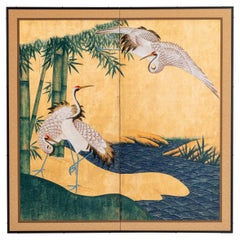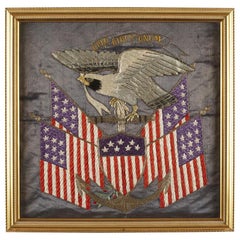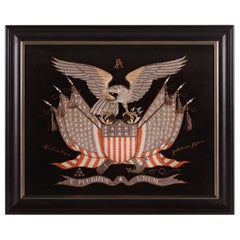Japanese Political and Patriotic Memorabilia
1
to
1
1
1
1
1
1
1
12,797
167
160
33
15
Place of Origin: Japanese
Japanese Screen Depicting USA Commodore Perry’s Flagship the USS Mississipi
Located in Amsterdam, NL
A rare and fine Japanese six-fold gold-leaf screen with the depiction of Commodore Matthew Perry’s flagship the USS Mississippi
Early Bakumatsu period (1853-1867)
Measures: H. 61 x W. 183 cm
Provenance:
Private collection, USA
On 8 July 1853 Commodore Matthew Perry with his paddle-wheel warships USS Mississippi and Susquehanna, and two sloops, with a total of 65 guns and little less than 1000 man, for the first time arrived in the harbour of Shimoda, in the bay of Edo, in his own words, “to open doors of commerce, and spread civilization to a backward people, and also to spread the Gospel of God to the heathen.” In Japanese parlance, the American ships quickly became known as “black ships,” depicted as demonic monsters. For the Japanese, these huge coal-burning ships...
Category
Late 19th Century Antique Japanese Political and Patriotic Memorabilia
Materials
Paint, Paper
Related Items
Contemporary Hand-Painted Japanese Screen of Cranes by the River
Located in 10 Chater Road, HK
The cranes by the river painting of this two-panel screen is hand-painted in watercolor, on squares of gold leaf which are applied by hand to the paper base over carefully jointed wo...
Category
2010s Japanese Political and Patriotic Memorabilia
Materials
Gold Leaf
Japanese Two Panel Screen, Chrysanthemums
Located in Hudson, NY
Beautiful white chrysanthemums are emphasized by heavy gold on a soft floral landscape, while gold clouds create a striking and dream-like floral scene. Gold leaf and gofun with min...
Category
Early 18th Century Antique Japanese Political and Patriotic Memorabilia
Materials
Gold, Gold Leaf
Pair of Japanese Screens
Located in Schellebelle, BE
Exceptional pair of Japanese screens, 20th century
Six parts, six times 45 cm wide
Gold spotted paper with parts of old screens.
Category
Mid-20th Century Japanese Political and Patriotic Memorabilia
Materials
Paper
Japanese 2-Panel 'Shunga' Screen with Finely Painted Erotic Depictions of Lovers
Located in Prahran, Victoria
A very finely painted two panel 'shunga' screen with scenes of naked erotic lovers in union.
The scene on the left panel simply depicts the lovers in ...
Category
Mid-20th Century Showa Japanese Political and Patriotic Memorabilia
Materials
Wood, Paper
H 41.74 in W 71.66 in D 0.87 in
Japanese Six Panel Screen: Egrets in the Rain
Located in Hudson, NY
Japanese Six Panel Screen: Egrets in the Rain
Mineral pigments on mulberry paper with tones of silver in the foreground
Signed and sealed 北遥 Hokuy...
Category
1930s Vintage Japanese Political and Patriotic Memorabilia
Japanese Six-Panel Screen Women of the Court in the Garden
Located in Hudson, NY
Japanese six-panel screen: Women of the Court in the Garden. Edo period (circa 1700) painting of an early Kano school subject matter: nobility socializing in a coutryard garden. Deta...
Category
Early 1700s Edo Antique Japanese Political and Patriotic Memorabilia
Materials
Gold Leaf
Japanese Two Panel Screen, Turkeys
Located in Hudson, NY
Mineral pigments on silk, mounted on a gold panel, in silk border. Signature and seal read: Yoho.
Category
Early 20th Century Japanese Political and Patriotic Memorabilia
Materials
Silk
Japanese Two Panel Screen Dragon in the Mist
Located in Hudson, NY
Ink (Sumi) on paper. Signature and Seal read: Kishi Ganku It is backed with paper covered in gold and silver flake. Kishi Ganku (1749 or 1756-1839) was the...
Category
Early 19th Century Edo Antique Japanese Political and Patriotic Memorabilia
Materials
Wood, Paper
Japanese Two Panel Screen: Mountains in the Mist
Located in Hudson, NY
Chinese School landscape ink painting on gilded silk by Yukimatsu Shunpo, signed and dated 1924. Yukimatsu Shunpo was born in Oita in 1897 and studied under Himejima Chikugai in Osak...
Category
Early 20th Century Taisho Japanese Political and Patriotic Memorabilia
Materials
Silk
Japanese Six-Panel Screen
Located in Stamford, CT
A six-panel Japanese paper screen with poems, autumn flowers, bamboo fence and Mandarin ducks. Poems are believed to be earlier but were probably...
Category
Mid-19th Century Edo Antique Japanese Political and Patriotic Memorabilia
Materials
Paper
Japanese screen two-panel
By Japanese Studio
Located in Brescia, IT
Eagle on a pine branch with traces of white snow.
A rare subject for this mid-century two-panel screen, painted in mineral pigments on gilded paper.
The screen is a nice size and is ...
Category
20th Century Showa Japanese Political and Patriotic Memorabilia
Materials
Paper
Japanese Six-Panel Screen, Chrysanthemums
Located in Hudson, NY
Japanese six-panel screen: Chrysanthemums, Edo period (circa 1800) painting of a variety of chrysanthemums in a garden landscape, with sparrows. Mineral p...
Category
Early 1800s Edo Antique Japanese Political and Patriotic Memorabilia
Materials
Gold Leaf
Previously Available Items
Patriotic "E Pluribus Unum" and Eagle Silk Embroidered White Fleet Souvenir 1909
Located in Colorado Springs, CO
Presented is a patriotic silk floss and metallic thread embroidered souvenir, circa 1909. The banner has a slate blue silk field, with "E Pluribus Unum" embroidered in gold thread on a bannerette above an American eagle with anchor and panoply of American flags. This embroidered banner was most likely made to celebrate in Japan, to celebrate the visiting US Navy men of the Great White Fleet...
Category
Early 1900s Antique Japanese Political and Patriotic Memorabilia
Materials
Silk
H 22 in W 22.5 in D 1.75 in
Elaborate Sailor's Souvenir Embroidery from the Orient With a Large Eagle
Located in York County, PA
ELABORATE SAILOR’S SOUVENIR EMBROIDERY FROM THE ORIENT WITH A LARGE FEDERAL EAGLE, CROSSED FLAGS, CANNON AND ANCHOR, OBTAINED IN YOKOHAMA, JAPAN, DATED 1906:
Between roughly 1885 and 1915, American sailors visiting the orient could obtain beautiful needlework embroideries on shore, with patriotic American themes. These extraordinary works of art were acquired as mementos of a long voyage, often with the hope that they might be presented as gifts for loved ones and friends.
Using silk floss, elaborately embellished with both silver and gold metallic bullion thread, and combining various types of embroidery work and stitchery, artists working the piers in port towns would create these elaborate pictures, customizing them to the buyer's content. Executed on velvet, like this example, or sometimes on silk, the most common devices included eagles, flags, and shields, often with various maritime elements, frequently personalized with names or initials, locations, and dates.
This particular example has all of the above. A spread-winged, war-like eagle is posed here upon clusters of arrows emerging from the apex of a federal shield, flanked on either side by trios of American national flags. Laurel leaves spring from the top of the shield, while a cannon barrel and an anchor extend from the base, with a stack of cannon balls to the left and a billowing streamer below. The familiar "E Pluribus Unum" motto appears on the streamer, separated by a single star. This is rather appropriate for the meaning of the phrase: "out of many, one."
The initials of the sailor, "AP," appear in fanciful text at the top, in the valley between the eagle's wings. To the left and right of the flags are the date "April 24th 1906." and "Yokohama, Japan." It is of interest to note that the count of 45 stars on each flag in the foreground is correct for the period, as well as the count of 13 stars and 13 pales (vertical stripes) on the shield.* The attention to detail is relatively amazing, especially given the point of origin. It was not uncommon for American-made patriotic objects to lack such detail.
Teddy Roosevelt was in the White House at the time that this textile was made. Utah became the 45th state in 1896. It had been attempting to gain statehood for many years, but remained a territory, primarily due to the fact that the Mormon Church and Utah authorities continued to be openly tolerant of polygamy. In 1890, Mormon Church President Wilford Woodruff published a manifesto that denounced the contract of “any marriages forbidden by the law of the land”. This gave way to Utah’s 1896 acceptance. The 45 star flag was generally used from that year until 1907, when Oklahoma joined the Union. Due to the Spanish-American War (1898) and Roosevelt’s famous world tour of the “White Fleet” (1907-1909), this was an extremely patriotic period.
When examining the level of craftsmanship, note the glass eye employed in the eagle, the fan-like sprays of feathers on the white portion of the wings, and the tassels carefully knotted from metallic bullion thread. Also note the treatment of the raised feathers on the neck, the scales on the talons, and the spiraling chain...
Category
Early 1900s Antique Japanese Political and Patriotic Memorabilia
H 24.5 in W 29.5 in D 2.5 in
A Silkwork with American Eagle made for the American Market.
Located in Downingtown, PA
The large silkwork depicts an adaption of the Great Seal- An American Eagle grasping an American Flag which overlaps a large anchor. A band reading E PLURIBUS UNUM sits behind the anchor. The whole overlaid with a shield form Stars & Stripes, arrows and an olive branch. Below a large Dragon looks up menacingly. An empty life preserver sits between which is designed to hold a photograph.
Background:
Japanese silkwork pictures were made for the American market from about 1885 through 1910. During the Spanish American War, American ships were stationed in Nagasaki. These silks were also sold at the Japanese Pavilion at the St Louis World Fair in 1904. This silkwork with such a nautical theme depicted was almost certainly purchased by one of the many American sailors who passed through Japan.
From December 1907 to February 1909, 16 battleships and 14,000 men of the US Navy steamed around the world on a mission of "Gunboat Diplomacy." The ships, commonly known as the "Great White Fleet" because of their white-painted hulls, called in ports the world over, impressing foreign dignitaries with the appearance of great power.
The ships were stationed for a time in Nagasaki. As Japanese and other Eastern influences in art were very popular, many men purchased the vibrant silks for souvenirs and mementos. Some of the ones with the strongest colour were seemingly not displayed at all, as there are no photographs in them and the condition suggests that they never made it out of the seaman’s trunk...
Background:
Japanese silkwork pictures were made for the American market from about 1885 through 1910. During the Spanish American War, American ships were stationed in Nagasaki. These silks were also sold at the Japanese Pavilion at the St Louis World Fair in 1904. This silkwork with such a nautical theme depicted was almost certainly purchased by one of the many American sailors who passed through Japan.
From December 1907 to February 1909, 16 battleships and 14,000 men of the US Navy steamed around the world on a mission of "Gunboat Diplomacy." The ships, commonly known as the "Great White Fleet" because of their white-painted hulls, called in ports the world over, impressing foreign dignitaries with the appearance of great power.
The ships were stationed for a time in Nagasaki. As Japanese and other Eastern influences in art were very popular, many men purchased the vibrant silks for souvenirs and mementos. Some of the ones with the strongest colour were seemingly not displayed at all, as there are no photographs in them and the condition suggests that they never made it out of the seaman’s trunk...
Category
19th Century Antique Japanese Political and Patriotic Memorabilia
WWII PERIOD (1941-45) JAPANESE NATIONAL FLAG
Located in York County, PA
WWII PERIOD (1941-45) JAPANESE NATIONAL FLAG, OF THE TYPE GIVEN TO JAPANESE SOLDIERS BY FAMILY MEMBERS, WITH WELL WISHES INKED IN THE WHITE FIELD, BROUGHT H...
Category




